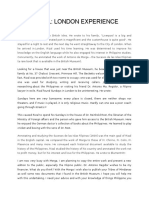0 ratings0% found this document useful (0 votes)
1K viewsRizal
Rizal
Uploaded by
Daincy MarianoRizal had a romantic interlude in Japan from February to April 1888. He befriended many Japanese people, including O-Sei-San who he fell in love with. They spent afternoons together where she helped him learn about Japanese language and culture. Reluctantly, Rizal departed Japan to continue his mission of liberating the Philippines, leaving behind his love O-Sei-San. He maintained correspondence with those he met, including Tetcho Suehiro who was inspired by Rizal's patriotism.
Copyright:
© All Rights Reserved
Available Formats
Download as PPTX, PDF, TXT or read online from Scribd
Rizal
Rizal
Uploaded by
Daincy Mariano0 ratings0% found this document useful (0 votes)
1K views20 pagesRizal had a romantic interlude in Japan from February to April 1888. He befriended many Japanese people, including O-Sei-San who he fell in love with. They spent afternoons together where she helped him learn about Japanese language and culture. Reluctantly, Rizal departed Japan to continue his mission of liberating the Philippines, leaving behind his love O-Sei-San. He maintained correspondence with those he met, including Tetcho Suehiro who was inspired by Rizal's patriotism.
Original Title
Rizal.pptx
Copyright
© © All Rights Reserved
Available Formats
PPTX, PDF, TXT or read online from Scribd
Share this document
Did you find this document useful?
Is this content inappropriate?
Rizal had a romantic interlude in Japan from February to April 1888. He befriended many Japanese people, including O-Sei-San who he fell in love with. They spent afternoons together where she helped him learn about Japanese language and culture. Reluctantly, Rizal departed Japan to continue his mission of liberating the Philippines, leaving behind his love O-Sei-San. He maintained correspondence with those he met, including Tetcho Suehiro who was inspired by Rizal's patriotism.
Copyright:
© All Rights Reserved
Available Formats
Download as PPTX, PDF, TXT or read online from Scribd
Download as pptx, pdf, or txt
0 ratings0% found this document useful (0 votes)
1K views20 pagesRizal
Rizal
Uploaded by
Daincy MarianoRizal had a romantic interlude in Japan from February to April 1888. He befriended many Japanese people, including O-Sei-San who he fell in love with. They spent afternoons together where she helped him learn about Japanese language and culture. Reluctantly, Rizal departed Japan to continue his mission of liberating the Philippines, leaving behind his love O-Sei-San. He maintained correspondence with those he met, including Tetcho Suehiro who was inspired by Rizal's patriotism.
Copyright:
© All Rights Reserved
Available Formats
Download as PPTX, PDF, TXT or read online from Scribd
Download as pptx, pdf, or txt
You are on page 1of 20
CHAPTER 12
Romantic Interlude in Japan (1888)
One of the happiest interludes in the life of Rizal was his sojourn
in the Land of the Cherry Blossoms for one month and a half
(February 28-April 13,1888).
Rizal Arrives in Yokahama.
Early in the morning of Tuesday, February 28,1888, Rizal arrived
in Yokahama. He registered at the Grand Hotel.
The next day he went to Tokyo and took a room at Tokyo Hotel.
He was impressed by the city of Tokyo.
He wrote to Professor Blumentritt: ‘‘Tokyo is more expensive
than Paris”.
Rizal in Tokyo
He was visited at his hotel by Juan Perez Caballero, secretary of the
Spanish Legation. Juan Perez Caballero invited Rizal to live at the
Spanish Legation.
He accepted the invitation for two reasons:
1. He could economize his living expense by staying at the legation
2. He had nothing to hide from the prying eyes of the Spanish
authorities
He checked out of Tokyo Hotel and lived at the Spanish Legation. He
and Perez Caballero became good friends.
In a letter to Blumentritt , he described the Spanish diplomat as
“a young, fine and excellent writer” and “an able diplomat who
had traveled much”.
He also wrote to Blumentritt. “Here you have your friend, Rizal
the wonder of the Japanese, who has the face of a Japanese but
does not speak Japanese.
Rizal decided to study the Japanese language. Being a born
linguist, he was able to speak it within a few days. He also studied
the Japanese drama(kabuki),arts, music and judo (Japanese art of
self-defense).
KABUKI JUDO
Rizal and the Tokyo Musicians.
One afternoon, Rizal was promenading in a street of
Tokyo near a park. Rizal heard the Tokyo band playing a
classical work of Strauss. He was impressed by the superb
performances of Western Music.
To Rizal’s amazement, they were talking in Tagalog. Rizal
approached them and the musicians were equally surprised
and delighted to meet him.
Rizal’s impression of japan
The things which favorably impressed Rizal in Japan were:
1. The beauty of the country.
2. The cleanliness, politeness and industry of Japanese
people.
3. The picturesque dress and simple charm of the Japanese
women.
4. They were very few thieves in Japan.
5. Beggars were rarely seen in the city streets.
One thing which he did not like in Japan, that was the
popular mode of transportation by means of rickshaws
drawn by men.
He felt disgusted at the way a human being was employed
like a horse.
ROMANCE WITH O SEI-SAN
One afternoon, a few days after he had moved to the
Spanish Legation in the Azabu district of Tokyo,
Rizal saw a pretty Japanese girl walking past the
legation gate.
Rizal made inquires among the legation employees
and learned from a Japanese gardener that she was
Seiko Usui, who lived in her parents’ home and she
used to pass by the legation during her daily
afternoon walk.
The following afternoon, Rizal and the gardener waited at the
legation gate and watched for the girl. As she approached, he took
off his hat and politely introduced himself as was the custom in
Germany.
Seiko was amused at the gallant gentleman from the Philippines
who spoke in halting Japanese. She replied in English, for she
knew that language and also French. And so the language barrier
was thus eliminated.
Since that first meeting, Rizal and O-Sei-San, as Rizal called her,
met almost daily.
Rizal saw in lovely O-Sei-San the qualities of his ideal
womanhood- beauty, charm, modesty and intelligence.
O-Sei-San reciprocated his affection, for it was the first time her
heart palpitated with joys to see a man of gallantry, dignity,
courtesy and versatile talents.
O-Sei-San, helped Rizal in many ways. She was his guide,
interpreter and tutor. She guided him in observing the shrines and
villages around Tokyo. She improved his knowledge of Nippongo
(Japanese language) and Japanese history. And she interpreted for
him the Kabuki plays and the quaint customs and mores of the
Japanese people.
O-Sei-San’s beauty and affection almost tempted Rizal to
settle down in Japan. At the same time, he was offered to a
good job at the Spanish Legation.
If he were a man of lesser heroic mould, of lesser will
power he would have lived permanently in Japan and
happily at that with O-Sei-San; but then the world, in
general, and the Philippines, in particular would have lost a
Rizal.
SAYONARA, JAPAN
On April 13, 1888, Rizal boarded the Belgic, an English
steamer, at Yokahama, bound for the United States.
He left Japan with a heavy heart, for he knew that he
would never again see this beautiful “ Land of the Cherry
Blossoms” and his beloved O-Sei-San.
His sojourn in Japan for 45 days was one of the happiest
interludes in his life.
O-SEI-SAN AFTER RIZAL’S DEPARTURE
About 1897, a year after Rizal’s execution, she married Mr. Alfred
Charlton, British teacher of chemistry of the Peer’s School in
Tokyo.
They were blessed by only one child- a daughter named Yuriko.
Mr. Charlton died on November 2,1915, survived by O-Sei-San,
and their daughter.
Yuriko later married Yoshiharu Takiguchi, son of a Japanese
senator.
O-Sei-San, as a widow, lived in a comfortable home in Shinjuko
district. She survived World War II, but her home was destroyed in
1944 by the U.S bombing of Tokyo.
She died on May 1, 1947 at the age of 80. She was buried in her
husband’s tomb at Zoshigawa Cemetery.
VOYAGE ACROSS THE PACIFIC
Despite his sorrowing heart, Rizal enjoyed the pleasant trans-
Pacific voyage to the United States.
On board the ship, he met a semi-Filipino family– Mr. Reinaldo
Turner, his wife Emma Jackson, their children and maid servant
from Panagasinan.
RIZAL AND TETCHO
Another passenger which Rizal befriended on board was Tetcho
Suehiro, a fighting Japanese journalist, novelist and champion of human
rights,who was forced by the Japanese government to leave the country,
just as Rizal was compelled to leave the Philippines by the Spanish
authorities.
Rizal told Tetcho the story of his life's mission to emancipate his
oppressed people from Spanish tyranny and of the persecutions
which he and his family suffered from the vindictive Spanish
officials and bad friars, causing him to flee to foreign countries
where he could freely carry on his libertarian activities.
Tetcho came to admire Rizal, whose patriotism and magnificent
talents greatly fascinated him and influenced him to fortify his own
crusade for human rights in his own country.
On December 1, 1888, Rizal and Tetcho parted ways- never to
meet again. Rizal remained in London to conduct historical
researches on Mora at the British Museum, while Tetcho returned
to Japan.
In 1889, after Tetcho's return to Japan, he published travel diary
which contained his impressions of Rizal. After the publication of
his travel diary, Tetcho resigned his position as editor of Tokyo
newspaper, Choya, and entered politics.
In 1890 he was elected as member of the lower house of the First
Imperial Diet (Japanese parliament),where he carries on his fight
for human rights.
In 1891,he published a political novel titled Nankai-no-Daiharan
(Storm Over the South Sea) which resembles Rizal's Noli Me
Tangere in plot. Three years later, he publisbed another novel
entitled O-unabara ( The Big Ocean) which was similar to El
Filibusterismo.
Tetcho died of heart attack in Tokyo in February, 1896.(ten
months before Rizal's execution). He was then 49 years old.
You might also like
- How Does Japanese Culture Impact On AdministrationDocument7 pagesHow Does Japanese Culture Impact On AdministrationAsif AbdullahNo ratings yet
- Chapter 12Document20 pagesChapter 12Trixie Rose Ebona CortezNo ratings yet
- The Second Travel of RizalDocument20 pagesThe Second Travel of RizalLeojelaineIgcoy100% (1)
- Rizal's Life, Works and WritingsDocument17 pagesRizal's Life, Works and WritingsDeroNo ratings yet
- Let's Start First With Introduction: The Trip To HongkongDocument5 pagesLet's Start First With Introduction: The Trip To HongkongKarmela Espinosa100% (1)
- Rizal Romantic Interlude in Japan 1888Document5 pagesRizal Romantic Interlude in Japan 1888Anna Rose LoboNo ratings yet
- Jose Rizal in JAPANDocument2 pagesJose Rizal in JAPANFrancesca Cordero0% (1)
- Hongkong, Macau and Japan RizalDocument9 pagesHongkong, Macau and Japan RizalBernard CastilloNo ratings yet
- XaxsaxaDocument2 pagesXaxsaxaMark UgsidNo ratings yet
- Chapter 13 Rizal Lesson Learned and ObservationDocument2 pagesChapter 13 Rizal Lesson Learned and ObservationMuamar Kian Ulangkaya100% (1)
- Rizal in Hongkong and JapanDocument13 pagesRizal in Hongkong and JapanAdrian GonzaloNo ratings yet
- Rizal Chap11Document17 pagesRizal Chap11Angelyme TayoNo ratings yet
- Chapter 11 Reviewer (Life and Works of Rizal)Document2 pagesChapter 11 Reviewer (Life and Works of Rizal)mcdo friesNo ratings yet
- Rizal in JapanDocument1 pageRizal in JapanKRISTINE CHRIZEL PURGANANNo ratings yet
- The Return of Rizal After 5 YearsDocument2 pagesThe Return of Rizal After 5 YearsCarmella Mae QuidiligNo ratings yet
- Misfortune in MadridDocument1 pageMisfortune in MadridJayceelyn OlavarioNo ratings yet
- ProfessionsDocument5 pagesProfessionsJ A M GamingNo ratings yet
- The Last Homecoming and Trial of RizalDocument1 pageThe Last Homecoming and Trial of RizalrizthieNo ratings yet
- Jose Rizal Life EventsDocument3 pagesJose Rizal Life EventsJonah Anne Aldea100% (1)
- Trial and Martyrdom of Jose RizalDocument9 pagesTrial and Martyrdom of Jose Rizaljose aranetaNo ratings yet
- Chapter 12 Rizal Lesson Learned and ObservationDocument2 pagesChapter 12 Rizal Lesson Learned and ObservationMuamar Kian UlangkayaNo ratings yet
- Chapter18 Rizal's Disappointments in MadridDocument22 pagesChapter18 Rizal's Disappointments in MadridEdmund Earl Timothy Hular Burdeos III100% (1)
- Rizal in Hong Kong and MacaoDocument2 pagesRizal in Hong Kong and MacaoNiccolo Ramos100% (1)
- Women of RizalDocument45 pagesWomen of RizalStephanie Love T. BaringNo ratings yet
- Rizal 1888-1892Document9 pagesRizal 1888-1892EmmanuelRodriguez100% (2)
- RIZAL CHAPTER 8 and 9Document6 pagesRIZAL CHAPTER 8 and 9Ken Eugene CabanelaNo ratings yet
- Rizal'S Life AND Works Rizal and His Time PrologueDocument12 pagesRizal'S Life AND Works Rizal and His Time PrologueCarandangjhessNo ratings yet
- Chapter 11 RizalDocument2 pagesChapter 11 RizalJoelmarMondonedoNo ratings yet
- Rizal's Life Family, Childhood, Education, andDocument25 pagesRizal's Life Family, Childhood, Education, andEngr. Kimberly Shawn Nicole SantosNo ratings yet
- Reflection Rizal's Grand TourDocument1 pageReflection Rizal's Grand TourEmmanuel Sindol100% (2)
- Rizal in LondonDocument32 pagesRizal in LondonMy HomeNo ratings yet
- Week 16-LIFE AND WORKS OF RIZALDocument4 pagesWeek 16-LIFE AND WORKS OF RIZALXienaNo ratings yet
- Rizal in America 1888Document19 pagesRizal in America 1888Jeric MillenaNo ratings yet
- First Homecoming of RizalDocument23 pagesFirst Homecoming of RizalJeremie ManzanoNo ratings yet
- Rizal Chapter 3 SummaryDocument1 pageRizal Chapter 3 SummaryAlfe Rosete Macarine100% (8)
- Jose Rizal in LondonDocument4 pagesJose Rizal in LondonShawn Michael Doluntap60% (5)
- Rizal's Visit To The United States (1888Document23 pagesRizal's Visit To The United States (1888Dandy Lastimosa Velasquez63% (8)
- Chapter 14 - RizalDocument11 pagesChapter 14 - RizalGio Franco Sampang100% (1)
- Jose Rizal Life, Works and Writings SummaryDocument18 pagesJose Rizal Life, Works and Writings SummaryErica P. Manlunas100% (1)
- Chapter 14 Rizal Lesson Learned and ObservationDocument3 pagesChapter 14 Rizal Lesson Learned and ObservationMuamar Kian Ulangkaya100% (2)
- What Are The Provisions Included in The Said Law?Document7 pagesWhat Are The Provisions Included in The Said Law?Natsu DragneelNo ratings yet
- Chapter 17, RizalDocument6 pagesChapter 17, RizalCarl Johnave Manigbas Monzon50% (2)
- Rizal in Gay Paris, 1889-90Document30 pagesRizal in Gay Paris, 1889-90Rachelle Mae SalvadorNo ratings yet
- Topic 7: Rizal Visits Japan, The United States, and Some European CountriesDocument25 pagesTopic 7: Rizal Visits Japan, The United States, and Some European CountriesShin YuNo ratings yet
- CHAPTER 3 Rizals EducationDocument11 pagesCHAPTER 3 Rizals EducationFrances Joy OcampoNo ratings yet
- Rizal Chapter 13-14Document14 pagesRizal Chapter 13-14Lance JayomaNo ratings yet
- SPAIN, Paris, Germany, Noli LatestDocument58 pagesSPAIN, Paris, Germany, Noli LatestAriel Dela CruzNo ratings yet
- 8 Rizals First Homecoming in CalambaDocument13 pages8 Rizals First Homecoming in CalambaENRIQUEZ, JETHRO C.No ratings yet
- Chapter 6,7,9 Rizal's LifeDocument4 pagesChapter 6,7,9 Rizal's LifeGinx VillafloresNo ratings yet
- Chapter 3 School Life at Ateneo 1Document16 pagesChapter 3 School Life at Ateneo 1kira100% (2)
- The Second Homecoming of RizalDocument5 pagesThe Second Homecoming of RizalMa. Louigie AgangNo ratings yet
- This Study Resource Was: Ingratitudes Was Rizal's Response To A Captain General Who Gave Him and His ColleaguesDocument2 pagesThis Study Resource Was: Ingratitudes Was Rizal's Response To A Captain General Who Gave Him and His Colleagues11 LamenNo ratings yet
- 7 Rizals - First Travel Abroad-Part 1Document56 pages7 Rizals - First Travel Abroad-Part 1Leah RoseNo ratings yet
- Ophthalmic Surgeon in Hong Kong (1891-92)Document37 pagesOphthalmic Surgeon in Hong Kong (1891-92)Einah EinahNo ratings yet
- Chapter 15Document50 pagesChapter 15Jen Isio100% (1)
- The Women in The Life of RizalDocument24 pagesThe Women in The Life of RizalQuennie Ann Aguinaldo100% (1)
- Chapter 11 in Hongkong and MacaoDocument1 pageChapter 11 in Hongkong and MacaoKaishe Ramos0% (1)
- Jose Rizal To Paris and BerlinDocument32 pagesJose Rizal To Paris and BerlinMJ Dalisay Caringal100% (1)
- RIZAL Chapter 5Document4 pagesRIZAL Chapter 5Plong PlongNo ratings yet
- RizalDocument3 pagesRizalkaki042997No ratings yet
- Romantic Interlude of Japan (1888)Document7 pagesRomantic Interlude of Japan (1888)Timothy Echavez VillanosNo ratings yet
- The Distinctive Afro-Asian Traditions and Values Which You Can Relate/identify With As An AsianDocument12 pagesThe Distinctive Afro-Asian Traditions and Values Which You Can Relate/identify With As An AsianWil MaNo ratings yet
- UntitledDocument369 pagesUntitledミャグマルジャブムンヒシュル・SangoNo ratings yet
- 2nd Summative Test Mapeh8Document3 pages2nd Summative Test Mapeh8Abigael CañazaresNo ratings yet
- N4 N3 N2 All FilesDocument151 pagesN4 N3 N2 All FilesReiyaKei100% (1)
- Japanese Language Proficiency Test JLPT N5 - Listening Exercise 25Document6 pagesJapanese Language Proficiency Test JLPT N5 - Listening Exercise 25rippvannNo ratings yet
- Educational Policy Outlook JapanDocument24 pagesEducational Policy Outlook JapanJosé Felipe OteroNo ratings yet
- Japanese Culture and LiteratureDocument22 pagesJapanese Culture and LiteratureVenice GarciaNo ratings yet
- Bu-Budo and Learning From ShogunDocument93 pagesBu-Budo and Learning From Shoguninsightsx100% (1)
- Teddy Roosevelt SwordsDocument9 pagesTeddy Roosevelt SwordsthealthnorNo ratings yet
- Japanese Culture 1Document20 pagesJapanese Culture 1Ace SongNo ratings yet
- India 2020-My Vision of A Prosperous IndiaDocument8 pagesIndia 2020-My Vision of A Prosperous IndiaNeetish Kumar Handa100% (2)
- His227 - Japan From Tokugawa Shogunate To Meiji RestorationDocument10 pagesHis227 - Japan From Tokugawa Shogunate To Meiji RestorationAjayi OpeyemiNo ratings yet
- Mapeh: Learning Activity SheetDocument7 pagesMapeh: Learning Activity SheetK ManjaresNo ratings yet
- ALSA Constitution 2012Document26 pagesALSA Constitution 2012Pratik BakshiNo ratings yet
- Foreign Policy Convergence in Pacific Asia: The Evidence From Voting in The UN General AssemblyDocument18 pagesForeign Policy Convergence in Pacific Asia: The Evidence From Voting in The UN General AssemblyWaayija SalmahNo ratings yet
- Indonesian Vs Japan System FarmingDocument1 pageIndonesian Vs Japan System FarmingVigna Pramechie LesmanaNo ratings yet
- Asian Civilization (History 2) MidtermDocument106 pagesAsian Civilization (History 2) MidtermMarkus WolfeNo ratings yet
- Hays 1808039Document112 pagesHays 1808039james tanNo ratings yet
- Youtube - Japanese Business Culture and EtiquetteDocument6 pagesYoutube - Japanese Business Culture and Etiquettekawsardu5271No ratings yet
- Woman's Farmer Level 5 WritingDocument3 pagesWoman's Farmer Level 5 WritingSamuel DyerNo ratings yet
- JET ALT Questions From Glassdoor: Compiled by U/velvetfieldDocument5 pagesJET ALT Questions From Glassdoor: Compiled by U/velvetfieldGeorge Lubiano PastorNo ratings yet
- Industria Auto Din JaponiaDocument76 pagesIndustria Auto Din JaponiaMircea Dan StanciuNo ratings yet
- Presentation 1Document9 pagesPresentation 1Angel Marie PestanoNo ratings yet
- XBU1204336240 Top 100 Global Innovators 2024 - Report - v9 - DIGITALDocument28 pagesXBU1204336240 Top 100 Global Innovators 2024 - Report - v9 - DIGITALAkhtar RasoolNo ratings yet
- Culture of Japan: Japanese LanguageDocument4 pagesCulture of Japan: Japanese Languagesharmaine1234No ratings yet
- Modern East Asia SyllabusDocument8 pagesModern East Asia Syllabuspaleoman8No ratings yet
- China and JapanDocument6 pagesChina and Japanumbertorondino6No ratings yet
- Closing Case: Tiny Islands, Big TroubleDocument3 pagesClosing Case: Tiny Islands, Big TroubleSoe LwinNo ratings yet
- Issue 39Document12 pagesIssue 39Chhem SronglongNo ratings yet

























































































